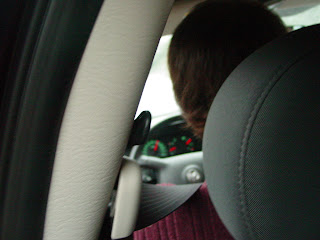End of rat parade

Just for a little recap, we had 13 groups (two students per rat). Each group had to spend at least one hour each day with their rat for two weeks. For motivational purposes the rats needed to be brought down between 5 to 10 percent of their free-feeding weight. If the rat is not hungry, it will not be motivated enough to press a lever for a food reward. So, the students weighed their rats on the first day to get the estimate of it's free-feeding weight and from then on based what they feed them on the ideal weight that they were hoping to achieve. The students weighed their rats each day and weighed the amount of food to give them each day. They then recorded this information in their "rat journals," along with a rationale for why they were feeding them the amount of food that they gave. They then brought their rats to the operant chambers (example to the left) and tried to shape a lever pressing behavior in their rat by reinforcing them with a small food pellet. When the rat was able to press the lever on its own, it would automatically receive a pellet. This is on a 1:1 ratio. After a rat learns the behavior and is able to press the lever without any reinforcement, the students were to switch to a higher ratio like a 2:1 ratio (rat presses the lever twice and gets one pellet). The goal was to get all the way up to a 10:1 ratio, but not all rat groups achieved this goal. Again, some groups just got stuck with rats that didn't want to do anything. Those with clever rats, or just plain hungry rats, were able to reach this goal and move on to more creative feats. Some tried extinction (not reinforcing the lever pressing behavior) for a day, and then trying the 1:1 ratio again on the next day to see how quickly the rat remembers. One activity that I thought was interesting was reinforcing the amount of time that the rat held the lever. One group did this. They shaped a behavior in the rat for pushing the lever down and holding it down. Eventually they would only give the rat a pellet if it held the lever down for 10 seconds. I thought that was pretty neat. Other groups utilized various variable rate ratios.
They then brought their rats to the operant chambers (example to the left) and tried to shape a lever pressing behavior in their rat by reinforcing them with a small food pellet. When the rat was able to press the lever on its own, it would automatically receive a pellet. This is on a 1:1 ratio. After a rat learns the behavior and is able to press the lever without any reinforcement, the students were to switch to a higher ratio like a 2:1 ratio (rat presses the lever twice and gets one pellet). The goal was to get all the way up to a 10:1 ratio, but not all rat groups achieved this goal. Again, some groups just got stuck with rats that didn't want to do anything. Those with clever rats, or just plain hungry rats, were able to reach this goal and move on to more creative feats. Some tried extinction (not reinforcing the lever pressing behavior) for a day, and then trying the 1:1 ratio again on the next day to see how quickly the rat remembers. One activity that I thought was interesting was reinforcing the amount of time that the rat held the lever. One group did this. They shaped a behavior in the rat for pushing the lever down and holding it down. Eventually they would only give the rat a pellet if it held the lever down for 10 seconds. I thought that was pretty neat. Other groups utilized various variable rate ratios.
All in all the students really enjoyed their experience with the rat labs . . . or at least I think they did. Most seemed attached to their little rodents, and most gave them names. Oh well, it is all over now. Grading rat journals is what I have to look forward to for this weekend . . . sigh.















